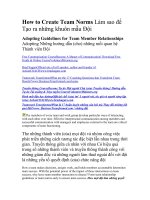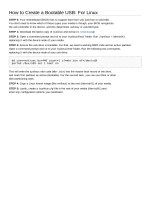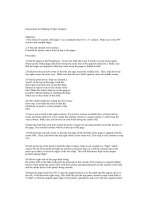running a side business, how to create a second income (2009)
Bạn đang xem bản rút gọn của tài liệu. Xem và tải ngay bản đầy đủ của tài liệu tại đây (8.61 MB, 292 trang )
NOLO
Create a Second Income
Attorney Richard Stim and Lisa Guerin, J.D.
BUSINESS
SIDE
Running a
®
How to
• Make money from the fi rst day
• Avoid personal liability
• Understand business tax basics
NOLO
YOUR LEGAL COMPANION
For more than 35 years, Nolo has been helping ordinary folks
who want to answer their legal questions, create their own
documents, or work with a lawyer more effi ciently. Nolo.com
provides quick information about wills, house buying, credit
repair, starting a business—and just about anything else that’s
aff ected by the law. It’s packed with free articles, legal updates,
resources, and a complete catalog of Nolo books and software.
To fi nd out about any important legal or other changes
to this book’s contents, sign up for our free update service
at Nolo.com/newsletters/index.html, or go to Nolo.com and
under “Products,” fi nd this book, and click “Legal Updates.”
And to make sure that you’ve got the most recent edition of
this book, check Nolo’s website or give us a call at 800-728-3555.
USA TODAY
The Nation’s Newspaper
USA TODAY, the nation’s largest circulation newspaper, was
founded in 1982. It has nearly 3.9 million readers daily, making
it the most widely read newspaper in the country.
USATODAY.com adds blogs, interactive graphics, games,
travel resources, and trailblazing network journalism, allowing
readers to comment on every story.
NOLO
and
USA TODAY
We believe accurate, plain-English legal information should help
you solve many of your own legal problems. But this text is not a
substitute for personalized advice from a knowledgeable lawyer.
If you want the help of a trained professional—and we’ll always
point out situations in which we think that’s a good idea—
consult an attorney licensed to practice in your state.
Please note
Attorney Richard Stim and Lisa Guerin, J.D.
How to Create a Second Income
How to Create a Second Income
BUSINESS
BUSINESS
BUSINESS
SIDE
Running a
First Edition OCTOBER 2009
Editor ILONA BRAY
Cover Design JALEH DOANE
Book Design SUSAN PUTNEY
Proofreading SUSAN CARLSON GREENE
Index SONGBIRD INDEXING
Printing DELTA PRINTING SOLUTIONS, INC.
Stim, Richard.
Running a side business : how to create a second income / by Rich Stim & Lisa Guerin.
1st ed.
p. cm.
ISBN-13: 978-1-4133-1067-2 (pbk.)
ISBN-10: 1-4133-1067-2 (pbk.)
1. Supplementary employment. 2. Part-time employment. I. Guerin, Lisa, 1964- II.
Title.
HD5854.5.S75 2009
658.4’21 dc22
2009021421
Copyright © 2009 by Nolo. All rights reserved. e NOLO trademark is registered in
the U.S. Patent and Trademark Office. Printed in the U.S.A.
USA TODAY®, its logo, and associated graphics are federally registered trademarks. All
rights are reserved. All USA TODAY text, graphics, and photographs are used pursuant
to a license and may not be reproduced, distributed, or otherwise used without the
express written consent of Gannett Co., Inc.
No part of this publication may be reproduced, stored in a retrieval system, or
transmitted in any form or by any means, electronic, mechanical, photocopying,
recording, or otherwise without prior written permission. Reproduction prohibitions do
not apply to the forms contained in this product when reproduced for personal use. For
information on bulk purchases or corporate premium sales, please contact Nolo’s Special
Sales Department. Call 800-955-4775 or write to Nolo, 950 Parker Street, Berkeley,
California 94710.
Acknowledgments
anks to Ilona Bray, Susan Putney, and Janet Portman.
Table of Contents
I
Your Business Companion 1
1
Starting the Right Side Business 3
Before You Start: Nine ings to Consider 5
Can You Really Maintain Your Full-Time Job and Your Side
Business? 8
Common Side Businesses 10
Do You Need a Business Plan? 23
Avoid Side-Business Scams 24
What If … ? Should You Consider Quitting Your Day Job? 26
2
If You Go Online 31
Free Stuff 33
Invoice Customers and Get Paid Online 37
Sell Stuff via Amazon or eBay 39
Earn Money With Ads and Affiliates 43
e (Very) Basics of Driving Traffic to Your Site 44
How to Build a Website in 24 Hours 48
Basic Legal Rules When Going Online 51
3
Managing Your Money 55
Record Keeping and Bookkeeping 57
Accounting Methods 59
What Is Cash Flow and Why Is It Essential? 61
Five Accounting Principles You Need To Know 63
What Is Forecasting? 65
Should You Separate Business and Personal? 67
Raising Money for Your Business 67
What’s the Difference? Equity vs. Debt 68
Borrowing With Credit Cards 68
Bank Loans 69
SBA Loans 70
Borrowing From Family and Friends 71
Social Lending Networks 72
Getting Paid 73
Invoiced Accounts 74
Checks 75
Getting Paid With Credit Cards 76
Ten Tips for Collecting Accounts Receivable 77
4
Protecting Personal Assets 83
Using Business Entities to Limit Liability 85
What Are You? Sole Proprietorship or Partnership? 86
What’s the Difference? LLC vs. Corporation 89
How to Convert to an LLC or a Corporation 92
An Interview With LLC and Corporations Expert
Anthony Mancuso 94
Insurance 97
Basic Coverage 97
Package Deals 102
Insurance for Employees 103
Ten Tips for Saving Money on Insurance 105
Reduce Your Risks 108
5
Avoid the Lawyers 111
Ten Common Contract Problems and How to Solve em 114
Drafting and Formatting an Agreement 119
Who Signs the Agreement? 121
When You Have to Review a Contract 121
Maintaining Paperwork 123
Are You Afraid of Negotiating Contracts? 123
Avoiding Legal Problems With Names and Trademarks 124
Perform a Simple “Knockout” Search 125
Federally Registering a Trademark 126
Staying Out of Trademark Trouble 128
Four Steps to Legally Protecting Your Business Ideas 130
What Ideas Do You Have? 132
Ensuring Rights: Registration and Other Measures 134
Chasing People Who Rip Off Your Ideas 138
Licensing or Selling Your Rights 139
What If You Copy Somebody Else’s Ideas? 139
Ideas Created by Your Employees or Contractors 140
Ten Ways to Save on Legal Fees 142
Evaluate Your Attorney’s Services 147
6
Licenses, Permits, and Other Paperwork 149
Basic Registration Requirements 150
Register Your Fictitious Business Name 153
If You Sell Goods, Get a Seller’s Permit 155
Permits and Licenses for Specialized Fields 156
7
Working From Home 157
Ten Tips for Maximum Home Office Efficiency 159
Self-Assessment: When Should You Move Your Side Business
Out of Your Home? 163
Studios and Storage: When You Need More Space 168
8
Working With Others 171
Employee vs. Independent Contractor: What’s the Difference? 173
Five Reasons Why Hiring an IC Is Usually a Better Choice For
Your Side Business 176
Legal and Paperwork Requirements: ICs 177
Legal and Paperwork Requirements: Employees 179
Ten Tips When Hiring Family Members 182
9
Marketing Basics 189
What’s the Difference? Marketing vs. Advertising 192
Ten Marketing Tips 192
Your Marketing Toolbox 198
Do You Need a Marketing Plan? 207
10
Taxes and Deductions 211
What’s the Difference? Hobby vs. Business 213
How the IRS Judges Your Business 213
Proving a Profit Motive 214
Classic Hobby Loss Abuse 216
Paying Taxes 219
Will You Get Audited? 219
How Businesses Are Taxed 220
What Taxes Your Business Will Have to Pay 222
Paying Estimated Taxes 224
Preparing Your Taxes 227
Keeping Records for the IRS 229
Tax Deductions 232
What’s a Tax Deduction Worth? 232
Tax Deduction Basics 236
Deducting Home Office Expenses 237
Qualifying for the Home Office Deduction 238
What You Can Deduct 241
Five Home Office Deduction Tips 243
Deducting Long-Term Assets 245
Immediate Deduction Using Section 179 245
Depreciation 246
Deducting Vehicle Expenses 247
Deducting Travel Expenses 249
Deducting Meals and Entertainment 251
An Interview with Attorney Stephen Fishman 252
Index 257
Your Business Companion
I
t seems like I’ve always had a side business. (e earliest one I can
remember was an after-school enterprise in which I charted my
friends’ biorhythms.) It wasn’t just the money; there were usually
other reasons. Sometimes, I wanted to learn new skills—for example,
when I learned how to produce audiobooks. Or, I wanted to exploit
and expand existing skills—for example, when I taught night classes for
paralegals. Sometimes, I wanted
to create something from scratch
and to take a shot at the brass
ring—like when I began writ-
ing children’s stories. And when
I performed in bands, it was so
much fun that I couldn’t believe
that I also got paid. To para-
phrase Will Rogers, I’ve never
met a side business I didn’t like.
One reason that side businesses
are so likeable is that they’re
always on the side. ey don’t
exist to create a primary source of
income. e pressure is off. Side
businesses create supplemental income, and, unlike your day job, you
call the shots. But the most surprising benefit of a side business is how it
affects your mind. It gives you something to think about, something to
manage, and something to root for. It’s a profitable daydream, a diversion
that improves your bottom line.
So, if a side business is so great, why hasn’t everyone started one? And
why is this the first book devoted totally to creating and running a side
business?
introduction
|
YOUR BUSINESS COMPANION
|
2
2
|
RUNNING A SIDE BUSINESS
As to the first question, some people just don’t want the hassle. Once
they finish their 9-to-5, they’re happy to put their feet on the ottoman
and watch Desperate Housewives. Of course, there are also people who
want to run a small side business but haven’t begun to do it. eir
major obstacle is that they don’t know how to go about it—for example,
they don’t know how to choose the right business, how to get started,
how to handle money, how to prepare taxes, how to market, or how to
deal with contracts. Perhaps they also lack the self-confidence and belief
that they can actually do it.
is brings us to our second question: Why hasn’t someone written
a book about running a side business? One reason could be that most
popular business books are written for a strike-it-rich reader. Publishers
are eager to preach to the big dreamers but apparently don’t think there’s
a market for those with lower expectations—those who simply want to
manage and profit from an enjoyable business diversion.
at’s unfortunate. If you’re a casual entrepreneur, you deserve a
legal and business guide that simplifies and explains all the confusing,
challenging, or just plain boring aspects of running a side business.
Good news! You’re holding that book.
I can confidently state that this is the best book for anyone interested
in running a side business. I believe that my co-author Lisa Guerin
and I have created a handbook that will give you all of the confidence,
reassurance, and tools you need to keep your side business stable and
prosperous.
—Rich Stim
1
cHAPtEr
Starting the Right Side Business
Before You Start: Nine ings to Consider 5
#1: How Will You Make Money?
5
#2: Are You Good at What You Do?
5
#3: Are You Experienced?
6
#4: What’s Your Competition?
6
#5: Are You Good With People?
6
#6: What’s the Market Demand?
6
#7: Will It Take Over Your Home?
7
#8: Will You Lose Your Job, Family, Money, or Mind?
7
#9: Sometimes the Best Choice for a Side Business Is None
of the Above
7
Can You Really Maintain Your Full-Time Job and Your
Side Business?
8
Common Side Businesses
10
Adsense and Affiliate Marketing
12
Bed and Breakfast
12
Beauty
13
Blogger
14
Catering and Food Preparation
14
Child Care
15
Cleaning and Janitorial
15
Consultant
16
Craftsperson
16
eBay/Amazon
16
Gardener or Landscaper
17
cHAPtEr 1
|
STARTING THE RIGHT SIDE BUSINESS
|
5
4
|
RUNNING A SIDE BUSINESS
cHAPtEr 1
|
STARTING THE RIGHT SIDE BUSINESS
|
5
4
|
RUNNING A SIDE BUSINESS
Graphic Artist/Designer 17
Home Health Care
18
Home Repair and Installation (Services)
18
Musician
19
Personal Assistant/Concierge
19
Personal Trainer/Fitness Instructor
20
Pets
20
Photographer
21
Programmer/Web Developer/App Developer
21
Property Management and Rental
22
Telemarketer/Salesperson
23
Do You Need a Business Plan?
23
Avoid Side-Business Scams
24
Medical Claims Processing Scams
24
Product Assembly Scams
25
Envelope-Stuffing Scams
25
Direct Sales Pyramid Schemes
25
Recognizing Other Work-at-Home Scams
26
What If … ? Should You Consider Quitting Your Day Job?
26
cHAPtEr 1
|
STARTING THE RIGHT SIDE BUSINESS
|
5
4
|
RUNNING A SIDE BUSINESS
cHAPtEr 1
|
STARTING THE RIGHT SIDE BUSINESS
|
5
4
|
RUNNING A SIDE BUSINESS
A
side business is a small enterprise that you run for supplemental
income. Side businesses typically augment a 9-to-5 paycheck or
bolster retirement savings. Because they’re small and personal-
ized, they often provide satisfaction, stimulation, and—if run properly
and prudently—long-term revenue and savings.
If you’ve already started a side business and you’re satisfied with your
choice, you can skip this chapter. But if you’re not sure what type of
side business is right for you, or you’re wondering if the business you’ve
already started is the best choice, or you’re not really sure you’re the right
person to be running a side business, then read on.
Before You Start: Nine ings to Consider
We wish you could simply spin a wheel to choose the right side business.
Because your choice is likely to involve some investment of time and
money, it’s best to weigh the choices. Here are nine things to consider
before starting.
#1: How Will You Make Money?
e bottom line in any side business is … well, the bottom line. is
may seem self-evident, but you would be surprised at how many people
start businesses without actually knowing how they will make money. If
you can’t explain to others in one sentence where the money will come
from, then you’ve got a hobby, not a business.
#2: Are You Good at What You Do?
It’s not enough to like what you do; you also need to be good at it.
Your side business will be most satisfying when your ability and your
ambition are closely matched. For example, suppose you want to teach
music to youngsters. You may be a great musician, but if you’re a poor
instructor, you must either improve your teaching skills or consider
another side business. You can get better on the job, but you must
consider whether you can afford the learning curve.
cHAPtEr 1
|
STARTING THE RIGHT SIDE BUSINESS
|
7
6
|
RUNNING A SIDE BUSINESS
cHAPtEr 1
|
STARTING THE RIGHT SIDE BUSINESS
|
7
6
|
RUNNING A SIDE BUSINESS
#3: Are You Experienced?
You’ll find it more satisfying (and probably more profitable) to pursue
an endeavor in which you have had some experience or at least some
exposure. For example, if you’ve helped your sister at several crafts fairs,
you’ll have some understanding of the crafts industry and how to sell
crafts. is is not to say that you can’t gain experience as you proceed
(that’s axiomatic), but having prior experience can shorten the learning
curve.
#4: What’s Your Competition?
Before plunging into a new venture, check out the breadth of your
competitors and ask yourself if the field is too crowded. Sometimes a
crowded field means there is more opportunity (consider the tens of
thousands of iPhone apps), but it can also mean no profits (Beanie
Babies anyone?). If a field is too crowded, consider whether there is a
variation, niche, or alternative. (Hmm, Beanie Baby phone apps?)
#5: Are You Good With People?
Before you choose a side biz, consider the human contact element. Your
choice of side business and your level of satisfaction will be directly tied
to whether you’re a “people person.” If you’re not good at dealing with
kids, for example, then obviously you should forget about working
as a children’s party clown. e good news is that there are many side
businesses—for example, website creation or home cleaning—that
require minimal human contact.
#6: What’s the Market Demand?
ere’s a reason why people line up for Apple’s new products. Apple
understands market demand. If you’re unsure whether market demand
exists (or whether current demand will continue), don’t start that side
business. Usually, you can determine the answers with some informal
market research. For example, a friend of ours wanted to teach guitar to
high school students until he asked around and learned that all the kids
cHAPtEr 1
|
STARTING THE RIGHT SIDE BUSINESS
|
7
6
|
RUNNING A SIDE BUSINESS
cHAPtEr 1
|
STARTING THE RIGHT SIDE BUSINESS
|
7
6
|
RUNNING A SIDE BUSINESS
wanted to be DJs, not guitar heroes. Sometimes, you can learn enough
by informally polling people in your area; in other instances, you may
need to use online tools, statistics, or demographics.
#7: Will It Take Over Your Home?
Most side businesses operate out of the home. Before claiming the
downstairs bedroom as your eBay shipping and storage center, it’s wise
to consult with your family or roommates. If space is a concern, you’ll
have less impact on home life if you maintain a small footprint—for
example, a Web designer, freelance writer, or a bookkeeper—or if you
work at your clients’ location—as does a handyman or an Internet
troubleshooter.
#8: Will You Lose Your Job, Family, Money, or Mind?
Keeping it together comes down to how you manage your time. For
example, if you run a website that generates ad revenue, do you have
the time to monitor Google analytics, tweak your site, and constantly
Twitter your customers with new offers? Does your free time sync up
with that of your customers—for example, can you install wireless
networks only during the evenings and weekends? Will you find yourself
managing your eBay PowerSeller account at your day job? Can you
estimate the hourly needs for your side business before committing to
it? For more on this, see the section below, “Can You Really Maintain
Your Full-Time Job and Your Side Business?”
#9: Sometimes the Best Choice for a Side Business Is None
of the Above
Keep in mind that a profit motive, by itself, is usually not enough to
sustain a side business. If your sole goal in starting a side business is
to feed your bank account, you may be better off with a part-time
job. With a job, you won’t have to drum up customers, manage your
money, take risks, and worry about cash flow. Your decision not to run
a side business isn’t a reflection on your talent, brains, or perseverance;
it’s more about your priorities. A side business can take up part (or
cHAPtEr 1
|
STARTING THE RIGHT SIDE BUSINESS
|
9
8
|
RUNNING A SIDE BUSINESS
cHAPtEr 1
|
STARTING THE RIGHT SIDE BUSINESS
|
9
8
|
RUNNING A SIDE BUSINESS
all) of your free time and, in combination with a full-time job, can be
downright exhausting.
Can You Really Maintain Your Full-Time Job
and Your Side Business?
Here are some things to consider about keeping your full-time job, your
side business, and your sanity.
Your employer may not share your enthusiasm for your side business.
Your first priority should be to keep things cool with your employer. It’s
especially important that your employer not perceive your side business
as competing in any way. Check
your employee handbook in
case your company has rules
regarding side businesses. Check
any other documents you signed
when you began working in case
you have agreed not to work
with anything that conflicts or
competes with your employer.
Don’t steal office supplies.
Don’t stock your side business
with supplies from your day
job. In e Scorecard at Work
(Holt), author Greg Gutfeld
says stealing office supplies is
one of the five fastest ways to get fired. You may rationalize this theft by
saying “the company can afford it.” But since office supplies account for
a fairly large chunk of the $67 billion lost to employee theft each year,
employers apparently don’t think they can afford it—and are now more
than ever on the lookout for disappearing staplers.
Don’t use information from work, including customer lists and trade
secrets.
Avoid using information you obtain at work for your side
business, no matter why you think it’s harmless borrowing. Every
cHAPtEr 1
|
STARTING THE RIGHT SIDE BUSINESS
|
9
8
|
RUNNING A SIDE BUSINESS
cHAPtEr 1
|
STARTING THE RIGHT SIDE BUSINESS
|
9
8
|
RUNNING A SIDE BUSINESS
employer has valuable confidential information that it wants to keep
under wraps. It could be a sales plan, a list of customers, a manufacturing
process, or a formula for a soft drink. In legal terms, these are your
employer’s trade secrets. You have an obligation to preserve these secrets,
whether or not you signed a nondisclosure agreement.
Don’t assume you own what you create for an employer. Even
without a written employment agreement, an employer often ends up
acquiring ownership of innovations you created in the course of your
employment. Tread especially carefully if your side business is based on
a product developed during your employment.
Go part-time, flextime, or telecommute. We’re mindful that you’re
reading this book to increase your income, not reduce it. But if you
can afford it, consider talking to your employer about: (a) flextime,
which lets an employee work a
nontraditional schedule—for
example, working a full-time
job in less than five days; (b)
telecommuting, which permits
you to work at home some or
all of the time; or (c) part-time/
job sharing, when two workers
share the duties of one full-
time job. Don’t be dismayed
if your employer doesn’t offer
these options—yet. You may be
able to convince your boss to
change course. Numerous books,
career counselors, and websites
are devoted to helping you achieve that goal. One site, Work Options
(www.workoptions.com), helps you write a proposal for your boss and
even provides scripted responses to typical objections.
Get organized. If keeping a job and running your side business
is making you feel scattered, take some time to improve your
organizational skills. Two of the most popular organizational gurus
cHAPtEr 1
|
STARTING THE RIGHT SIDE BUSINESS
|
11
10
|
RUNNING A SIDE BUSINESS
cHAPtEr 1
|
STARTING THE RIGHT SIDE BUSINESS
|
11
10
|
RUNNING A SIDE BUSINESS
are David Allen, author of Getting ings Done (Penguin), and Julie
Morgenstern, author of Organizing From the Inside Out (Holt). Fans of
David Allen have memorized
his mantra, “Do it, delegate it,
or defer it.” Julie Morgenstern
concentrates on organizing your
mind first and tasks second.
Unless you get your mind in
order, she says, you’ll continue
to create unrealistic schedules
that increase frustration.
Get help. If you can afford
it, sometimes the best way
to juggle your job and side
business is to bring in someone
else to help with your business.
You can hire a contractor or
employee and pay them based upon sales or other revenue. e point
is to find someone to help with the heavy lifting. You may be able to
accomplish this without cash payment. Many contractors—particularly
in bad economies—are willing to consider bartering. Several websites
facilitate long-distance bartering—for example, to exchange online site
creation for advertising services. Use terms such as “barter network” or
“corporate barter” to locate these services.
Common Side Businesses
Below, we’ve provided an alphabetical list of some common side busi-
nesses. e choices are unlimited—we know someone who sells hand-
painted sand dollars—and this list is simply a short survey of popular
opportunities. A lot of the information in this section is derived from
the Occupational Outlook Handbook, available at the Bureau of Labor
Statistics (www.bls.gov).
cHAPtEr 1
|
STARTING THE RIGHT SIDE BUSINESS
|
11
10
|
RUNNING A SIDE BUSINESS
cHAPtEr 1
|
STARTING THE RIGHT SIDE BUSINESS
|
11
10
|
RUNNING A SIDE BUSINESS
Using a Side Business to “Hedge Your Bets”
Continental Express regional jet pilot Chad Pensiero hopes to fly
international routes for a major airline someday. But, unsure he’ll
ever see that time because of industry turmoil, he’s becoming a
newspaper publisher on the side.
In October 2004, Pensiero and Jason Foley, a copilot who also
works for Continental Express, delivered the first issue of their
biweekly, free-distribution shopper. ey were already thinking
big. Pensiero, who lives in East Stroudsburg, Pennsylvania, hoped
to double e Pocono Classifieds’ first-issue circulation of 10,000 by
December and make the paper profitable by the third issue.
“I’ve always wanted to work for myself,” says Pensiero, 30, who has
flown for the airline for six years. He says he’s confident his own job
is secure. But he was driven to start the side business by the general
uncertainty in the airline industry.
“I’m senior enough to do OK,” he says, “but I’ve always wanted
to fly a 777 into London on a foggy morning, and that may never
happen. After September 11, everything changed in the business.”
To start the newspaper, Pensiero took voluntary six-month unpaid
leave. While that gave him the time he needed, it meant forgoing
half his pilot pay of about $60,000 for the year. Pensiero and Foley
refinanced their houses and invested their savings in the business,
which cost more than $25,000 to start.
Pensiero has no plans to leave aviation. But he says all around him,
pilots are hedging their bets, starting new businesses such as selling
real estate or taking other sales jobs. “It’s pretty common to start a
business,” he says.
“Airline workers branch out to make ends meet,” by Chris Woodyard,
October 21, 2004.
cHAPtEr 1
|
STARTING THE RIGHT SIDE BUSINESS
|
13
12
|
RUNNING A SIDE BUSINESS
cHAPtEr 1
|
STARTING THE RIGHT SIDE BUSINESS
|
13
12
|
RUNNING A SIDE BUSINESS
RESOURCE
For a thorough list of inexpensive-to-start side businesses, see
101 Businesses You Can Start, With Less an One ousand Dollars: For
Stay-at-Home Moms & Dads, by Heather Shepard (Atlantic).
Adsense and Affiliate Marketing
If you maintain a blog or website, Adsense and Affiliate marketing
can be peripheral or primary sources of income for your side business.
Both of these marketing businesses place ads on your site and you
earn money when someone either clicks the ad (AdSense) or buys the
product in the ad (Affiliate marketing)—for example, people click
through your site to buy a book at Amazon. (ere’s much more to
these marketing businesses and we provide details in Chapter 2).
RESOURCE
See How I Made My First Million on the Internet: And You Can
To o, by Ewen Chia (Morgan James).
Bed and Breakfast
We’re hesitant to include B&Bs as a side business—they seem more like
a full-time job—but research indicates that many people who run B&Bs
do so in addition to a full-time job (or in connection with a spouse
who is not working). A bed and breakfast side business must conform
to city and state laws, obtain local licenses, abide by local zoning rules
(and collect local taxes), and will need to carry commercial liability
insurance. You’ll have to be a people person, a decent marketer, and
willing to enforce the house rules. is is a competitive field affected
by general travel trends. According to the Professional Association of
Innkeepers International, there are more than 20,000 licensed bed and
breakfasts in the United States.









